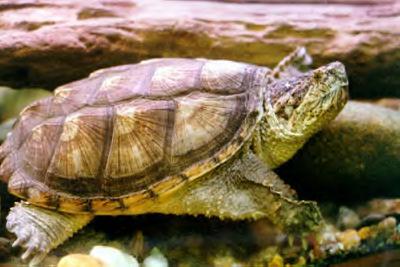|
|
Canku Ota |
|
|
(Many Paths) |
||
|
An Online Newsletter Celebrating Native America |
||
|
May 19, 2001 - Issue 36 |
||
|
|
||
|
Turtle's Race With Bear |
||
|
"Hah," shouted Bear, not even giving his old friend a greeting. "What
are you looking at, Slow Turtle looked at Bear. "Why do you call me slow?" Bear snorted. "You are the slowest of the animals. If I were to race you, I would leave you far behind." Perhaps Bear never heard of Turtle's big race with Beaver and perhaps Bear did not remember that Turtle, like Coyote, is an animal whose greatest speed is in his wits. "My friend," Turtle said, "let us have a race to see who is the swiftest." "All right," said Bear. "Where will we race?" "We will race here at this pond and the race will be tomorrow morning when the sun is the width of one hand above the horizon. You will run along the banks of the pond and I will swim in the water." "How can that be?" Bear said. "There is ice all over the pond." "We will do it this way," said Turtle. "I will make holes in the ice along the side of the pond and swim under the water to each hole and stick my head out when I reach it." "I agree," said Bear. "Tomorrow we will race." When the next day came, many of the other animals had gathered to watch. They lined the banks of the great pond and watched Bear as he rolled in the snow and jumped up and down making himself ready. Finally, just as the sun was a hand's width in the sky, Turtle's head popped out of
the hole in the ice at the Bear walked quickly to the starting place and as soon as the signal was given, he rushed forward, snow flying from his feet and his breath making great white clouds above his head. Turtle's head disappeared in the first hole and then in almost no time at all reappeared from the next hole, far ahead of Bear. "Here I am Bear," Turtle called. "Catch up to me!" And then he was gone again. Bear was astonished and ran even faster. But before he could reach the next hole, he saw Turtle's green head pop out of it. "Here I am, Bear," Turtle called again. "Catch up to me!" Now bear began to run in earnest. His sides were puffing in and out as he ran and his eyes were becoming bloodshot, but it was no use. Each time, long before he would reach each of the holes, the ugly green head of Turtle would be there ahead of him calling out to him to catch up! When Bear finally reached the finish line, he was barely able to crawl. Turtle was waiting there for him, surrounded by all the other animals. Bear had lost the race. He dragged himself home in disgrace, so tired that he fell asleep as soon as he reached his home. He was so tired that he slept until the warm breath of the Spring came to the woods again.
"My relatives," Turtle said, "I wish to thank you. Today we have shown Bear that it does not pay to call other people names. We have taught him a good lesson." Turtle smiled and a dozen other turtles, all just like him, smiled back. "And we have shown the other animals," Turtle said, "that Turtles are not the slowest of the animals."
|
|
Color and Print Your Own Snapper |
(Chelydra serpentina)
|
•Phylum: Chordata •Class: Reptilia •Order: Testudines •Family: Chelydridae |
|
| Snapping turtles are freshwater turtles that live in the Americas. There are three species:
the Alligator, Common, and Florida Snapping Turtles. The Alligator snapping turtle is the largest of the North
American freshwater turtles. These turtles reach 50 or more pounds, although the average-sized adult weighs 20-30
lbs. Snapping Turtles have large heads which cannot be withdrawn into the small shell. They rely on their strong jaws for defense and can bite hard if disturbed. They live in stagnant ponds, swamps and slow-running rivers. Since the Alligator Snapping Turtle lives mainly on fish, it is slaughtered by fishermen and is now on the endangered list. |
 |
| Common Snapping Turtles can sniff out carrion (dead animals), which they add to their
diet of plants, small birds and fish. They are so fearless and aggressive that on occasion, they have been known
to attack swimmers. Because of their unique ability to detect dead and rotting flesh, Common Snapping Turtles have
been used to help police search for human corpses! If the common snapping turtle is pestered while on land, it will repeatedly try to bite. Its neck is extremely long, and it can snap or bite as quickly as lightning strikes. Indeed, even a small snapper can inflict a painful wound with its hooked beak. If handled, which is definitely not recommended, be very careful. Pick it up by its tail and keep the belly side of the shell facing toward your body, because a well placed bite -from the common snapping turtle can sever a few fingers at one time. |
|
| Geographic Range: The snapping turtle's range stretches from S. Alberta and east to Nova Scotia in the north, extending south all the way to the Gulf of Mexico and into central Texas. Physical Characteristics The common snapping turtle averages 8-12 inches long and 10-35 pounds. The snapping turtle normally has a shell length ranging from 8 -18 1/2"and has a tail nearly as long as the shell. The tail has saw-toothed keels on it. The shell ranges in color from dark brown to tan and can even be black in some individuals. Snapping turtles have characteristic tubercles on their necks and legs. Plastrons of snapping turtles are very small and leave much of the extremities exposed. Snapping turtle necks, legs, and tails have a yellowish color and the head is dark in color. |
|
| Natural History: | |
| Food Habits Snapping turtles will eat nearly anything that they can get their jaws around. They feed on carrion, invertebrates, fish, birds, small mammals, amphibians, and a surprisingly large amount of aquatic vegetation. Snapping turtles kill other turtles by decapitation. This behavior might be territoriality towards other turtles or a very inefficient feeding behavior. |
|
| Reproduction Mating takes place from April to November. In the mating process, the male positions himself on top of the female's shell by grasping the shell with his claws. He then curves his tail until his vent contacts the female's vent. Fertilization takes place at this time. After the eggs have developed sufficiently in the female, she excavates a hole, normally in sandy soil, and lays as many as 83 eggs. The eggs take 9-18 weeks to hatch depending on the weather. Interestingly, female snapping turtles sometimes store sperm for several years. Sperm storage allows individuals to mate at any time of the year independent of female ovulation, and it also allows females to lay eggs every season without needing to mate. |
 |
| Behavior Snapping turtles are not social creatures. Social interactions are limited to aggressive interactions between individuals, usually males. Many individuals can be found within a small range; snapping turtle density is normally related to the amount of available food. Snapping turtles can be very vicious when removed from the water, but they become docile when placed back into the water. Snapping turtles like to bury themselves in mud with only their nostrils and eyes exposed. This burying behavior is used as a means of ambushing prey. Snapping turtles have a small growth on the front of their tongues that resembles a wriggling worm. To capture fish, the snapping turtle opens its mouth to make the "worm" visible. When a fish comes to investigate the lure, the snapping turtle grabs it with its strong jaws. |
|
| Habitat Snapping turtles only live in fresh or brackish water. They prefer water bodies with muddy bottoms and abundant vegetation because concealment is easier. Biomes: freshwater lake, freshwater rivers Conservation/Biodiversity Snapping turtle populations are not close to extinction or even threatened. Habitat destruction could pose a danger to snapping turtle populations at a later time. Some individuals are killed for food which does impact the population, but in a very minor way. |
 |
| Economic Benefits for Humans: Positive Snapping turtles are used by many people in turtle stews and soups. Snapping turtle shells were used in many ceremonies among Native Americans. The shells were dried and mounted on handles with corn kernels inside for use as rattles. Negative Snapping turtles consume the young of some game fish. The impact of snapping turtles on these populations is minimal. Snapping turtles are known to kill young and adult ducks and geese, but once again the effects are minimal. |
|
|
The
Common Snapping Turtle |
|
|
|
||
|
|
||
| Canku Ota is a free Newsletter celebrating Native America, its traditions and accomplishments . We do not provide subscriber or visitor names to anyone. Some articles presented in Canku Ota may contain copyright material. We have received appropriate permissions for republishing any articles. Material appearing here is distributed without profit or monetary gain to those who have expressed an interest. This is in accordance with Title 17 U.S.C. section 107. | ||
|
Canku Ota is a copyright © 2000, 2001 of Vicki Lockard and Paul Barry. |
||
|
|
|
|
|
The "Canku Ota - A Newsletter Celebrating Native America" web site and its design is the |
||
|
Copyright © 1999, 2000, 2001 of Paul C. Barry. |
||
|
All Rights Reserved. |

 It was
an early winter, cold enough so that the ice had frozen on all the ponds and Bear, who had not yet learned in those
days that it was wiser to sleep through the White Season, grumbled as he walked through the woods. Perhaps he was
remembering a trick another animal had played on him, perhaps he was just not in a good mood. It happened that
he came to the edge of a great pond and saw Turtle there with his head sticking out of the ice.
It was
an early winter, cold enough so that the ice had frozen on all the ponds and Bear, who had not yet learned in those
days that it was wiser to sleep through the White Season, grumbled as he walked through the woods. Perhaps he was
remembering a trick another animal had played on him, perhaps he was just not in a good mood. It happened that
he came to the edge of a great pond and saw Turtle there with his head sticking out of the ice. One?"
One?" starting line. "Bear," he called, "I am
ready."
starting line. "Bear," he called, "I am
ready." It was not
long after Bear and all to other animals had left the pond that Turtle tapped on the ice with one long claw. At
his sign it a dozen ugly heads like his popped up from the holes all along the edge of the pond. It was Turtle's
cousins and brothers, all of whom looked just like him!
It was not
long after Bear and all to other animals had left the pond that Turtle tapped on the ice with one long claw. At
his sign it a dozen ugly heads like his popped up from the holes all along the edge of the pond. It was Turtle's
cousins and brothers, all of whom looked just like him!